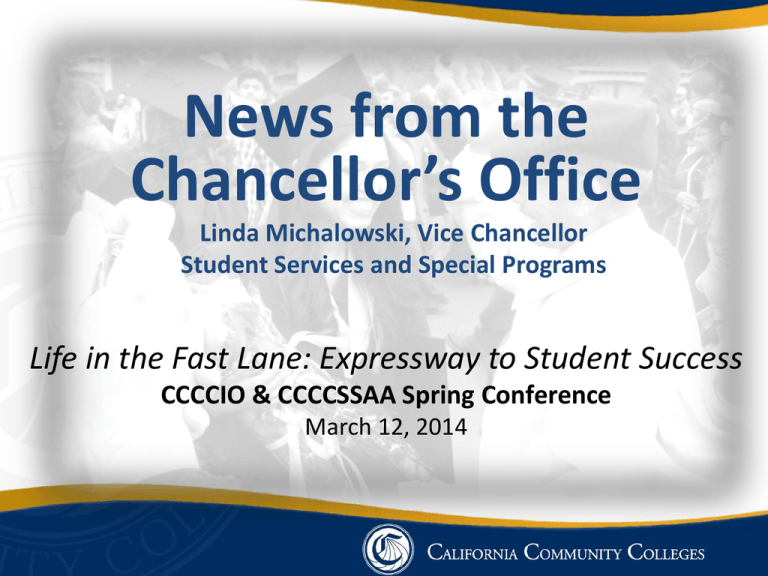News from the Chancellor`s Office
advertisement

News from the Chancellor’s Office Linda Michalowski, Vice Chancellor Student Services and Special Programs Life in the Fast Lane: Expressway to Student Success CCCCIO & CCCCSSAA Spring Conference March 12, 2014 Student Services Programs Updates • • • Enrollment Priorities SSSP & BOG Fee Waiver Student Success Technology • • • • • • Student Equity Transfer Veterans Mental Health DSPS Financial Aid Enrollment Priorities (T. 5 S. 58108) • Builds upon the Student Success Task Force recommendations by prioritizing access for certain groups of students • Specifies how certain groups of students should receive priority registration • Outlines complex requirements for students to lose priority registration –Includes consideration for appeals for disabled students –Includes a consideration for probationary students’ improved progress –Pertains to special student populations as well (Veterans, Foster Youth, EOPS, DSPS, CalWORKs) Newest Developments • Earlier legislation provided Veterans and Foster Youth top tier of priority. • AB 595 (Gomez) (Oct. 2013) provided DSPS and EOPS “top tier” priority • Budget Act Language (July 2013): added CalWORKs as a “top tier” priority group Enrollment Priority Key Elements • These groups now have equal and highest enrollment priority: – Veterans and – Foster youth/former foster youth – DSPS students – EOPS students – CalWorks students –IF they have completed orientation, assessment and developed student education plans. –Continuing students lose priority for being on academic or progress probation for two consecutive semesters or having earned more than 100 degree-applicable units (excluding ESL, basic skills) Enrollment Priority Exemptions, Appeals & Notification • Exemptions and Appeals –Students enrolled in high unit majors or programs –Units earned from credit by exam, AP, IB, are not counted • Colleges must have an appeals process available –Disabled students who applied for accommodations but did not receive them in a timely manner can appeal –As of Spring 2013, colleges must notify students on probation, who have earned 75% or more of the 100 unit cap, of their potential loss of priority Matriculation Student Success and Support Program • Known as the Matriculation Program Now called the Student Success and Support Program • 8 funded components 3 funded core services: orientation, assessment, counseling, advising, and other student education planning services • Colleges required to provide core matriculation services, but students not required to complete them Institutional AND student requirements Incentivizes student completion of core services • Stand-alone program planning Clear link to student equity planning • Funding allocated based on enrollment data for new and continuing students Funding formula includes services provided as well as enrollment • Incomplete data reporting on matriculation services Data required for funding Linked to Student Success Scorecard Student Success and Support Program Planning and Implementation Timeline Fiscal Year 2012-13 System-level Planning Year: • Implementation workgroups convened October 2012 to develop proposals for title 5 Matriculation revisions, new allocation formula, & revised MIS data elements & definitions • New program planning & budget process developed • SB 1456 effective January 1, 2013 Fiscal Year 2013-14 District/College-level Planning Year: • Allocations based on enrollment only, new formula not applied • Funding targeted to core services (1-year exemption permitted by request) • Develop program plans • Implement MIS changes to ensure accurate and complete data reporting • Regulations effective October 19, 2013 • Convene noncredit work group Fiscal Year 2014-15 District/College-level Implementation Year 1: • Program plans and budgets submitted • Continue to ensure accurate and complete data reporting • Allocations based on enrollment only, new formula not applied • First legislative implementation report due July 1, 2014 (biannually thereafter) Fiscal Year 2015-16 Implementation Year 2: • FY 15-16 allocations based on 14-15 yearend data reported • Application of funding formula begins this year • 80% of prior year funding guaranteed Fiscal Year 2016-17 Implementation Year 3: • FY 16-17 allocations based on 15-16 year-end data reported • 50% of prior year funding guaranteed (returns to 95% thereafter) • Legislative report due July 1, 2016 SB 1456 Student Success and Support Program Credit Funding Formula College’s Potential Population of Students to Receive Services Students Served at the College Initial Orientation (SS06)** 10% Unduplicated Credit Student Headcount* Base Funding Floor $35K or 10% Initial Assessment (SS07)** 10% (academic year = summer, fall, winter, spring) (whichever is greater) Abbreviated SEP (SS09)** 10% College Match 3:1*** Counseling/Advising (SS08) 15% Comprehensive SEP (SS09) 35% At Risk Follow-Up Svc (SS10) 15% 40% *Includes CA resident students enrolled as of census in at least 0.5 credit units, (STD7) headcount status “A,” “B,” “C,” excludes special admits Other Follow-Up Svc (SS11) 5% 60% **Include pre-enrollment services provided for students with SB record ***Match may include A&R, & SSSP related technology & research Student Success and Support Program Core Services Orientation; Assessment; Counseling, Advising & Other Education Planning Services; and Follow-up: Required for at-risk students: • Enrolled in Basic Skills courses • Have not identified education goal and course of study • Are on Academic or Progress Probation – at risk of losing enrollment priority and BOG Fee Waiver Noncredit Funding • Colleges administering non-credit programs certified eligibility in July 2013 • Funding for FY 2013-14 and 2014-15 will be based on formula used from 2001-02 through 2008-09 • Separate noncredit Program and Budget Plans will be required for 2014-15 • New funding formula will be developed during 2013-14 for implementation in 2015-16 • New formula will be based on a combination of eligible students and services Student Success and Support Program • Funding – Carryover of 13-14 funds – 6 months – Credit SSSP can be used for Non-Credit SSSP in 13-14 – Earn SSSP $ through FTES generating courses – Spend SSSP $ only on non- FTES generating Services – Proposal to revise 3:1 Match requirement SSSP Plan Template Student Success and Support Program • MIS Data Elements – SS09 – Ed Plan – Abbreviated & Comprehensive ed plan in one semester – SS06, SS07 & SS09 refined definition of 3-year req. for returning student to be reported as being “initial” SSSP Technology Projects – 3 Grants • RFA 13-082: The Online Education Initiative – Governed through consortium agreements between colleges, this grant seeks to leverage technology to expand online education, streamline processes, improve success and retention, enhance student services and provide professional development support for online education. • RFA 13-083: The Common Assessment Initiative – Provide a common assessment instrument for each of the curricular areas of English, math and English as a Second Language and a common delivery, administration and data collection and evaluation system to the benefit of all California Community Colleges. • RFA 13-084: The Education Planning Initiative – Provide a comprehensive, technology-based education planning system. The system includes tools for education planning and degree audit as well as, an underlying system of data required for a statewide education planning. Underlying data includes, electronic transcripts, articulation between community colleges and to four year institutions, assessment and program inventories. Oversight and Coordination of Technology Initiatives 3 Advisory committees, 4 Steering Committees, 1 Executive Workgroup(Ed Collaborative) TTAC Members: CEO(2-4), CSSO(2), CIO(1),ASCC(6),CAPED(1),CBO(1) ,CCCLC(1),RP(1), CISO(2), CSEA(1),FCCC(1), Student(1), CCCCO Staff: VC Tech, VC Student Services, VC Academic Affairs, Tech Staff(1), Academic Affairs staff(1), Palomar & CCC Tech Directors, OEI, CAI, EPI Directors Common Assessment Steering Committee Ed Planning Steering Committee Online Education Steering Committee Project Director: CAI Project Director: EPI Project Director: OEI Work Groups -Math, English, ESL, Multiple Measures Work Groups -Artic/Curr Inventory -Ed Plan / Degree Audit Work Groups -Instructional Standards, Exchange, CMS, Online PD CCCApply Steering eTranscript Steering User Experience Steering Committee Project Directors: CAI, EPI, OEI Technical Advisory Project Directors: CAI, EPI, OEI Project Directors: OEI, EPI, CAI, TTIP-North, TTIP-South, Cal-PASS Plus, ASSIST, Kresge, C-ID CCCCO: AA, SS, Tech Professional Development Advisory Project Director: CAI, EPI, OEI Education Collaborative • • • • • • • • • • • EPI Steering Committee Faculty (4) • General Counselor (COAGC liaison) (1) • Counselor ,Transfer Center Director (1) • Counselor for Special Populations (1): Noncredit, Vets, Athletes, Foster Youth • Faculty Articulation Officer(1) SSMPA President (1) SSSPAC - liaison (1) Advisors(1) Financial aid(1) CSSO (2), Student Services Deans (2), who have experience with Noncredit, Veterans, Athletes, and/or Foster Youth CISO (1) CIO (1) A&R (2) Categorical Program Directors with responsibility for EOPS/CARE, CalWORKs, DSPS (2) • • Researcher (1) Student (2) • Staff – EPI Project Director – CCCCO • Student Services (1) • Technology (1) – Total 21 / with staff 24 • Includes connection to existing committees • Committee will convene work groups as appropriate. • Workgroup composition will be determined by the committee OEI Steering Committee • Faculty (9), include experience in – Science, CTE, humanities(3) – SACC Liaison(1) – Counselor - transfer center director (1) – Librarian – CCLC (1) – Articulation Officer (1) • DE Coordinator (2) • CSSO (1) • Tutoring (1) • CIO (2) • CISO (1) • Educational Technology Staff (2) • Tutoring center experience • Students (1) • CEO (1) • • • • • Financial Aid (1) SSSPAC Liaison (1) CBO(1) A&R(1) Project Staff – OEI Project Director – OEI Dean Academic Affairs – OEI Director of Accessibility – OEI Director of Data Analytics • CCCCO Staff – Technology (1) – Academic Affairs (1) – Student Services (1) • Total 24 / including staff 31 – – Committee will convene work groups as appropriate. Workgroup composition will be determined by the committee • • • • • • • • CAI Steering Committee Faculty (6) – Math(2) • Basic Skills(1) – English(2) • Basic Skills(1) – ESL (2), one noncredit Assessment Directors (2) – Multiple measure or non credit experience SSPAC Liaison (1) – Multiple measure or non credit experience Assessment Workgroup Liaison (1) CSSO(1) CIO(1) Student Services Deans(1) CISO(1) • • • • • • • K-12 – Curriculum Instruction Steering Committee (1) – Assistant Superintendent– District/CIA (1) – CDE – Keric Ashley SSMPA (1) CEO (1) Research(1) Student(1) A&R(1) Staff – CAI Project Director – Cal-PASS Plus Director, Jim Lanich – CCCCO • Technology (1) • Student Services (2*) • Academic Affairs(1) Total 22 / including staff 28 Student Success Centers • Kresge Grant • Purpose • Timeline Student Equity Background 1992 — BOG adopts a policy to ensure that districts develop, implement, & evaluate a student equity plan. 1996 — BOG requires student equity plan as a minimum standard for receipt of state funding. 2002 — BOG agrees to develop title 5 regulations requiring colleges to develop Student Equity Plan. 2003 — Chancellor's Office provided guidelines to colleges for development of the plan Student Equity Background 2005 — Chancellor's Office asked colleges to update/complete Student Equity plan 2008-09 to 2012-13 economic downturn resulted in budget cuts, suspension of regulatory requirements, and categorical flexibility 2011-12 — Student Success Task Force and Student Success Act of 2012 (SB1456) reaffirm student equity 2013 — Student Equity Workgroup convened Student Equity Background 2014—Governor proposes to include an additional $100 million of SSSP funding to • “close achievement gaps in access and success in underrepresented student groups, as identified in local student equity plans.” • if approved, current budget bill, SB 851 (Leno), specifies that the Chancellor’s Office shall allocate funds “in a manner that ensures districts with a greater proportion or number of students who are high-need, as determined by the Chancellor’s Office, receive greater resources to provide services to these students.” Student Equity Background Governor’s new proposal for student equity SSSP funding is based upon similar concepts found in the new K-12 Local Control Funding Formula: • Provide more money to districts where “the need and the challenge is greatest.” • Give local districts more authority to decide how to spend the money, and hold them accountable for the results Funding for Student Equity is a proposal and is subject to change. Student Equity Requirements • Coordinate development of SSS Program Plan (SB 1456) with the Student Equity Plan • Establish a Student Equity Planning Committee • Identify strategies to address/monitor equity • Mitigate disproportionate impact on students • Coordinate interventions and services for students at risk of academic progress or probation (Title 5, Section 55100) Student Equity Plan Template What is Student Equity Planning? Success Indicators • • • • • • Planning Steps Access • Course Completion • ESL and Basic Skills Completion • Degree and Certificate • Completion Transfer • Student Success and Support • Services: The effect of mandatory participation of new students in • SSSP services the other indicators Establish Committee Conduct Research Develop Goals and Outcomes Develop Actions to Address and Monitor Disparities Implement Actions Coordinate with the SSSP Plan (SB 1456) Review progress and Make Needed Changes *Disaggregate data by student demographics Student Equity Requirements Required Populations to be addressed: • American Indians or Alaskan natives • Asians or Pacific Islanders • Blacks • Hispanics • Whites • Men • Women • Persons with disabilities. Student Equity Requirements • Draft Student Equity Plan Timeline: Planning timeframe: minimum of 3 years Year-end Report Initial Plan Due November 21, 2014 Student Equity Planning Resources Chancellor’s Office Student Equity web page: http://extranet.cccco.edu/Divisions/StudentServ ices/StudentEquity.aspx Student Equity Fact Sheet Student Equity Plan Template Guides for Measuring Disproportionate Impact in Equity Plans Transfer • Associate Degrees for Transfer – 18,000 unduplicated applicants to CSU in 2014 vs. 11,000 in 2013 – By 2013 over 1,000 new ADTs created – Reflects over 90% of majors Transfer • SB 440 – Padilla – endorses statewide TMC approach – calls for additional TMCs in at least four Areas of Emphasis • ASSIST – Next Generation project – live in Feb 2015 Veterans Services • 3rd Annual Veterans Summit in December 2013 Bigger and better! – Included faculty track sponsored by Academic Senate on evaluating military service for credit – 52 Veterans Resource Centers – Included UC and CSU veterans services representatives • 4th Annual planned for Dec. 4-5, 2014 in SF Student Mental Health • 108 out of 112 colleges have utilized resources from the CCC SMHP. • All webinars are archived and can be accessed 24/7. • Other resources available: – Healthy Transitions curriculum for foster youth – Online searchable database of SMH best practices – Fact sheets on student veterans, transition-aged youth, student success and mental health. Student Mental Health • Suicide prevention training available to all 112 colleges via the At-Risk / Kognito training modules. • 23 Campus Based Grants have been extended through Sept. 30, 2014. DSPS • CCCCO Workgroups to address: –DSPS-related Title 5 Regulations –DSPS Allocations methodology DSPS • Sidekick (www.toolsthatinspire.com): –Launched this year –Merges several CCCCO-funded grant projects on instructional content and technology on one site Financial Aid SB 1456 BOG Fee Waiver Conditions • Places conditions on eligibility for BOG Fee Waiver. Students must meet academic and progress standards, as defined by the BOG • The academic conditions would be phased in over a reasonable period of time as determined by the BOG. • Requires adequate and reasonable notification to students New BOG Fee Waiver Regulations • Regulations Approved: January 14, 2014 • Issues raised: – Alignment with federal SAP standards – Requested exemptions for EOPS and DSPS students as was done for foster youth – Concerns by advocacy groups reflected notification to students about the potential loss of eligibility and an appeals process. Although these items are addressed in the regulations, no additional funding/staffing has been included in order to provide the notification, appeals process and support services. – The Board of Governors passed the regulations as presented. Title 5 Changes for BOGW • Appeal process must be established due to extenuating circumstances, or a student with a disability didn’t receive reasonable accommodations in a timely manner or didn’t receive support services or other circumstances that impacted the student’s economic situation. – Foster youth shall not be subject to this loss. Colleges must advise students about student support services available to assist them in maintaining eligibility. – Districts may allow students who have demonstrated significant academic improvement to retain or appeal the loss of the BOG Fee Waiver. – Extenuating circumstances includes special consideration of the specific factors associated with Veterans, CalWORKs, EOPS and DSPS student status. – A student who successfully appeals the loss of enrollment priority shall also have the BOGW eligibility restored. Student notification for BOGW • 58621 (c): districts shall prominently display and disseminate policies ensuring that students are advised about the student support services available to assist them in maintaining and reestablishing BOG Fee Waiver eligibility. • 58621 (d): students placed on academic or progress probation shall be notified of their status no later than 30 days following the end of the term that resulted in their probation. • 58621 (f): districts shall begin notifications to students following the spring 2015 term. • 58621 (f): implementation for Fall 2016: loss of eligibility shall NOT occur prior to Fall 2016. • Common Core implementation • Dual Enrollment legislation Thank you.











